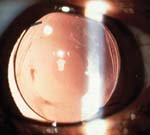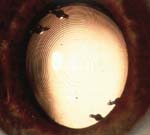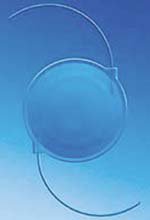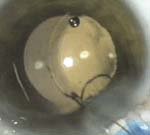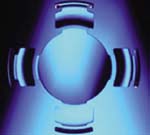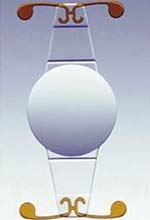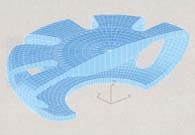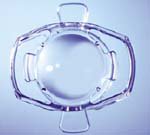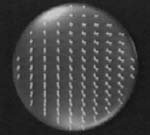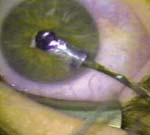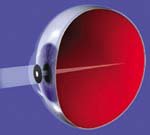Binkhorst Lecture: presbyopic correction from a surgeon’s perspective
Surgical correction of presbyopia will be an area of tremendous growth potential as the population ages.
2003 Binkhorst Lecture |
|
“I was fortunate enough to know Cornelius Binkhorst, and I’ve also been fortunate enough to know all 25 of the Binkhorst lecturers before me, and that makes this very special for me,” said Richard L. Lindstrom, MD, the 2003 Binkhorst Lecturer, as he addressed the audience prior to his lecture. “Cornelius Binkhorst was very special. I got to know him through membership in the International Intraocular Implant Club, of which he was a founding member and president. He exemplified very well the characteristics of integrity, innovation, perseverance and leadership,” Dr. Lindstrom said. |
Even for a well-corrected presbyopic patient with a monofocal lens implant it is difficult to see at close distance. I am presbyopic, and I find it a significant handicap. Perhaps it is fair to say presbyopia is really the first complication of lens implant surgery.
In the U.S. population, 51% of the population is presbyopic (141,480,000 people). If you are looking for a handicap to overcome, this is certainly one that creates a tremendous opportunity. Although not all patients would be interested in the surgical treatment of their presbyopia, perhaps as many as 68,000,000 potential surgical eyes could be treated if we had an effective, safe therapy.
Current treatment
Most patients with presbyopia wear glasses, either reading glasses or bifocals. Some patients have been treated by achieving monovision with contact lenses (5%). A smaller subpopulation has had LASIK, conductive keratoplasty or other surgical procedures to achieve monovision (5%). An even smaller group of patients has been implanted with multifocal IOLs (4%). And although there are some patients who have been implanted with an accommodating IOL (less than 1%), surgical correction of presbyopia is clearly in its early years.
From my early work with IOLab, a company that no longer exists, to now, the development of IOLs has been a passion of mine for over 20 years.
There is no surgical technology, perhaps other than monovision by a surgical procedure which is an off-label use, approved by the Food and Drug Administration for presbyopia correction. Many of the technologies that I discuss here are emerging and are in early development stage or in clinical trials. This is a group of select technologies that I have played a role in developing, and/or I am implanting today for evaluating future opportunities.
Multifocal IOLs
|
Nuvue (IOLab). The Nuvue multifocal IOL had a two-zone “bull’s eye” bifocal design. It had a central near zone with a 4-D add. My collaborators on this implant were Dick Keates and John Nielsen. Using primarily extracapsular surgery or phacoemulsification with a 6 mm to 7 mm incision, we achieved almost 80% J3 or better, and about 50% 20/40 or better with this technology.
Almost 20 years postop, one of my patients is still seeing 20/25 and J1 without correction.
Diffractive IOL (3M Vision Care). I had the honor of serving as the medical director for 3M Vision Care while they were in that business for 12 years. One of the products 3M Vision Care developed was a diffractive multifocal IOL, and I was the lead investigator on the project.
This lens implant was used fairly widely throughout the world. The 1-year U.S. FDA clinical study data showed 57% of patients saw 20/40 and 78% J3 or better. These were first-generation products and were released between 1985 and 1988.
|
AcrySof ReSTOR. The technology that evolved from 3M Vision Care was acquired by Alcon. The AcrySof ReSTOR is a three-piece acrylic IOL with PMMA haptics that has both diffractive and refractive optics. Overall it has a 6-mm optic with a central 3.6-mm diffractive portion.
Because of its design, which is pupil independent, there is likely to be less night symptoms and higher quality of vision when the pupil comes down in bright light. This lens will likely be an excellent IOL.
Array (AMO). The first and currently only lens that has FDA approval in the United States is the Array. I have had the opportunity to consult with Allergan, now Advanced Medical Optics, and also serve as a clinical investigator for this project.
The Array is a silicone lens with five progressive near- or distance-dominant zones. This is the lens that has developed the greatest results and also the greatest following to date in the world. In one study, results reported were 97% uncorrected visual acuity at J3 or better and greater than 20/40 at 3 months postop.
Early multifocal IOL studies
The reason that the improvement in results since the days of the IOLab and the 3M diffractive lenses has been so dramatic is that we moved from one-piece lenses with 6 mm to 11 mm incisions to implanting foldable IOLs through small incisions, which allowed more high quality control of astigmatism. We also began to achieve better results when we began to get comfortable with performing refractive lensectomy and applying this technology for the treatment of presbyopia.
From the early multifocal IOL studies we learned with multiple regression analysis that the key to a happy patient is to have them reach 20/30 and J3 or better. In those studies, some patients would begrudgingly admit that they were OK with less, but really to be happy, 20/happy, was 20/30 and J3. To achieve that, the patient needed to have less than 1 D of residual ametropia and less than 1 D of residual astigmatism, which meant that accurate biometry and refractive cataract surgery skills were essential.
We learned that if we focused on biometry, refractive surgery skills, patient selection and proper surgery selection, a broad array of patients were happy with this technology. This was the first technology that really put significant pressure on the surgeon to perform, and this was what has driven the refractive surgery/cataract surgery combination.
Accommodative IOLs
|
DualFlex. This is a concept, not an actual IOL design. Raymond M. Stein, MD, developed what he calls his DualFlex technique, which uses two piggybacked STAAR IOLs – one plate-haptic in the capsular bag and one three-piece IOL in the ciliary sulcus.
He reports that In a series of hyperopic patients, 62.5% achieved 20/40 for distance and 83.3% J4 or better for near. This concept of increased depth of focus in piggyback lens implantation was first described by James Gills, MD, but Dr. Stein is the person who applied it to a significant number of patients.
I have implanted some of these lenses and have found that it does give increased depth of focus in the hyperopic group, but I have not found good results in the myopic group.
CrystaLens AT-45 (C&C Vision). It is likely that the CrystaLens, invented by J. Stuart Cumming, MD, and developed by C&C Vision, will be the first approved accommodative IOL in the United States. The CrystaLens is a modified plate haptic lens with a 4.5 mm optic. Atropine is given postop to allow the lens to fixate posteriorly. Good quality of vision has been achieved in U.S. clinical trials and also outside the United States.
Looking at the data from a series implanted by I. Howard Fine, MD, 100% of his bilaterally implanted patients achieved a 20/happy result, that is 20/32 and J3, and 83% were 20/25 and J2. If surgeons apply this technology along with good biometry and careful astigmatism management, we will have extraordinarily happy patients.
|
Akkommodative 1CU (Human Optics). Another lens that has been used abroad but not in the United States is the Akkommodative 1CU, a hydrophilic acrylic IOL with a 5.5-mm optic. It is a posterior vaulted lens that primarily utilizes anterior movement of the optic to achieve an accommodative amplitude in the range of 1.5 D to 2 D. This range is probably not quite good enough. From the multifocal IOL study, we found that to push a patient into the happiness zone we need to achieve 3 D of accommodative amplitude at a minimum. It is difficult to achieve that by simply the forward movement of an IOL.
FlexOptic (Quest Vision). I have been working with the developers at Quest Vision on an IOL that not only moves forward, but also has an optic shape change during accommodation. This single-piece silicone IOL has a “balloon” haptic structure. The optic is anterior and as the ciliary muscle contracts and the zonules relax, the lens vault moves forward and the anterior curvature of the lens changes. Accommodative amplitudes of up to 4 D have been measured in the laboratory, and this will soon be evaluated in clinical trials.
Synchrony (Visiogen). The Synchrony is a one-piece silicone lens that has a dual optics system – a minus-power posterior optic to correct error and a high-power anterior optic for accommodation.
| ||
Accommodating IOLs should be available to us soon and will be a major advance in presbyopic correction, but again, achieving 20/happy is dependent on the surgeon’s performance, high quality biometry and high quality refractive cataract surgery skills.
New technology lens
Light Adjustable Lens (Calhoun Vision). One lens concept that may take a tremendous amount of pressure off the surgeon in regard to biometry and astigmatism management is the Light Adjustable Lens (LAL). The LAL has an optic that can be activated in situ with ultraviolet light so that the polymer is “cured” in the optic to achieve a permanent result. With this lens you can correct myopia, hyperopia or astigmatism, and perhaps create a customized lens to treat the ideal wavefront aberration of a given individual’s eye.
Intracorneal implants
|
Small diameter corneal inlay (Bausch & Lomb). The small diameter corneal inlay (SDCI), a 45% water hydrogel meniscus bifocal lens, was originally developed by Chiron. Daniel Durrie, MD, Graham Barrett, MD and I implanted a series of patients with this lens approximately 7 years ago. Bausch & Lomb is the current holder of this technology. I recently called in eight of my patients to review them at 5 years postop. We found that 100% of these patients were 20/30 or J3 or better. The median UCVA was 20/25 and J2; some of the patients were totally spectacle-independent.
Paraxial adaptive optic implant (AcuFocus). The AcuFocus uses a small aperture principle. After the correction of ametropia with LASIK, an optic is implanted with the LASIK flap still lifted for the purpose of improving near vision. Preliminary clinical trials are under way clinically in Mexico, and early results are promising.
Conclusion
When I look at the technologies that I have had the opportunity to work with, I find that monofocal lenses give approximately 30% of patients 20/happy, that is 20/30 and J3 or better. The first generation multifocal IOLs and accommodative IOLs push the rate to perhaps 60%. However, we are looking for a technology that will generate a 90% rate. When we find a technology that can provide a 90% happiness quotient, which is a patient-driven result as far as demand, we will see a huge growth opportunity in this presbyopic population.
The presbyopic population is expanding. It is the largest existing group of refractive errors. The baby-boomer population seems to have a great interest in looking at alternatives to spectacles for their presbyopic handicap. Correction with multifocal IOLs is now giving good results in properly selected patients, and at least in the United States, the most rapidly growing refractive procedure today is refractive lensectomy.
In coming years, we will see an explosive development of accommodative IOLs, new technology lenses, light-adjusted lenses, as well as corneal inlays, which will expand our options significantly in the treatment of presbyopia.
For Your Information:
- Richard L. Lindstrom, MD, chief medical editor of Ocular Surgery News, is a clinical professor of ophthalmology at the University of Minnesota, Minneapolis, and managing partner of Minnesota Eye Consultants, PA. He is a consultant for AcuFocus, AMO, AVS, Bausch & Lomb, Calhoun Vision, C&C Vision, Refractec, STAAR Surgical, TLC, Tracey, Visijet and Visx.

 The Binkhorst lecture and medal, named for IOL pioneer Cornelius
D. Binkhorst, were established in 1975. Each year, ASCRS awards the medal to an
individual who has followed in Dr. Binkhorst’s footsteps through
outstanding contributions to the understanding and practice of cataract surgery
and IOL implantation, according to the society.
The Binkhorst lecture and medal, named for IOL pioneer Cornelius
D. Binkhorst, were established in 1975. Each year, ASCRS awards the medal to an
individual who has followed in Dr. Binkhorst’s footsteps through
outstanding contributions to the understanding and practice of cataract surgery
and IOL implantation, according to the society. 